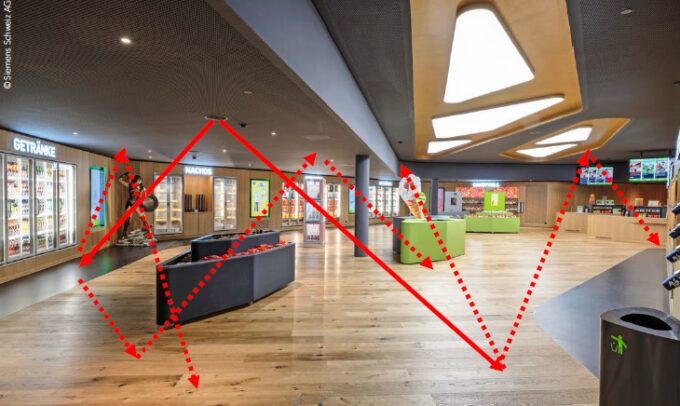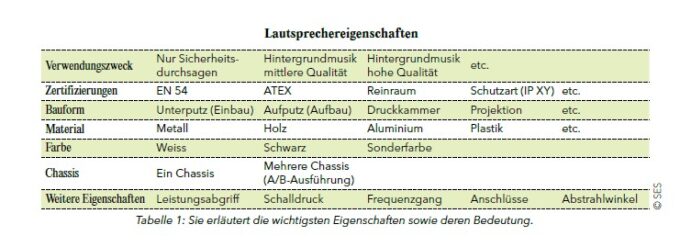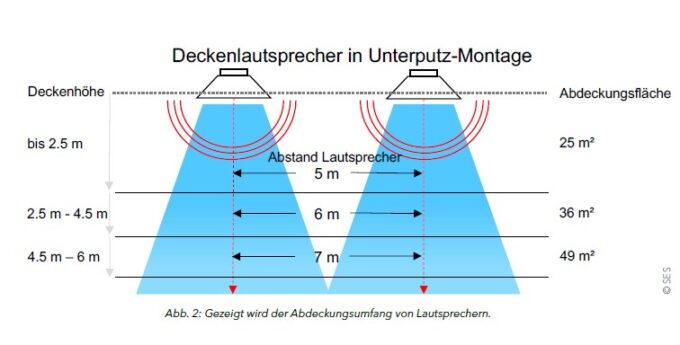Building services engineering: planning of sound reinforcement areas
When an emergency event occurs in a building, the persons concerned must be informed about it as quickly as possible and encouraged to rescue themselves. The alarming of the endangered persons can be done by a voice alarm system (SAA) or an electro-acoustic emergency warning system (ENS). How are such systems planned so that in the end the endangered persons also initiate self-rescue in the event of an incident?

In the case of the SAA and ENS system types, in addition to the targeted alarm via loudspeakers or other alarm transmitters, a certain degree of fail-safety is also provided. Colloquially, such systems are also called Evak systems or ELA (electroacoustic loudspeaker system), although these terms do not make any statement about the quality or functionality of the system.
Reach vulnerable people
In addition to reaching the people at risk, it is central that they respond correctly. The focus of evacuation systems, also known as evac systems, is on acoustic alerting by voice. This method brings many advantages, such as the possibility of individual announcements as well as the quick response of the endangered persons. After all, one of the most important goals of such systems is sufficient intelligibility. It can be verified at the end of the installation by means of a measurement. In the industry, this is referred to as the STI (Speech Transmission Index) measurement. STI can be measured in several ways: For Evak systems, the STI-PA (Speech Transmission Index for Public Address Systems) measurement method has proven itself in practice.
Decisive factor
We all know the situation: In a conversation, you don't understand the other person well because he or she is too far away, the surroundings are very loud, or other influences impair communication. The situation is similar with evac systems: the acoustic conditions must be right so that the people at risk also understand how they must react in an emergency.
Room acoustics
Every room behaves acoustically differently. Certain rooms have rather "dry" room acoustics. This means that the materials in the room absorb many sound waves and do not send them back. The materials tend to be soft (e.g. carpets, perforated ceilings, etc.). When an announcement is made in such a room, it tends to be easily understood. The announcement "reverberates" only a little in this case.
Rooms where there is reverberation are the opposite. The materials in such a room are rather hard (glass, stone, concrete, etc.). They reflect back many sound waves. When an announcement is made in a "reverberant" room, it is difficult for the people there to understand the announcement. The room acoustics have a decisive influence on how good the intelligibility is, but also on how the room climate feels to the user (see Fig. 1).
Noise level
Disturbing noises are familiar from everyday life (e.g. street or construction noise). In a room, disturbing noises have a negative influence on intelligibility.
Imagine the following situation: You are at a station and hear an announcement: The "useful signal" is the loudspeaker announcement with important information; the "noise" is a passing train. In practice, therefore, the so-called "signal-to-noise ratio" is decisive. The useful signal (in our example, the announcement) should be at least ten decibels (dB) higher than the interfering signal (in the example, the passing train). If this practical value is adhered to, interfering signals still have a negative influence on intelligibility, but this is relatively low.
Other acoustic influences
Besides the rather rudimentary influences described above, there are many other points to consider regarding acoustics, such as the topic of frequency range, reverberation (or RT 60) or masking effect. These also have relevance for good intelligibility, but the focus of this article is on the planning of sound reinforcement areas.
Choosing the right speaker
As is well known, loudspeakers are used as the main alarm transmitters in Evak systems. The design is usually in 100 volts. This means that the loudspeakers are driven by 100 volts from the power amplifiers (at full output) and the signal is picked up at the loudspeaker with the help of a transformer. This technology brings advantages in such systems.
For example, the cable runs can be very long and many speakers can be connected in series per speaker line. In addition, an individual power tap per speaker is possible. The loudspeakers are available in a wide variety of designs and have different characteristics depending on the design. So it is important to choose the right speaker type for the required application. For example, built-in and surface-mounted loudspeakers are best suited to achieve a uniform, wide-area sound coverage that is easy to understand. Projection loudspeakers, on the other hand, are mainly used in aisles where directional sound propagation is to be achieved.
Due to their weather resistance, the usual places of use for pressure chamber loudspeakers are mainly outdoors or in noisy environments such as industrial or production halls. For special application of tunnel sound reinforcement, which makes absolutely highest demands on planning, acoustics and loudspeakers, specially developed boundary horns are available.
Table 1 explains the most important speaker characteristics and their meaning.

Planning of sound reinforcement areas
Due to the acoustic influences described, it is not always easy to plan how many loudspeakers are necessary in which case, or where and how they must be mounted in order to achieve sufficient intelligibility. In practice, a distinction is made between two areas: simple sound reinforcement areas and sophisticated sound reinforcement areas.
With simple sound reinforcement surfaces, the acoustic influences tend to be positive or low. We have a rather low noise level, the room height and the reverberation time are rather low and the used surfaces in the room have good absorption properties. Typical examples are offices, meeting rooms, open-plan offices, training rooms or similar rooms and areas (many soft materials, rather quiet environment, etc.). For these sound reinforcement areas, it is relatively easy to estimate how many loudspeakers are needed in certain areas for the final result to be adequate. Figure 2 (see below) is a good indicator to estimate how many square meters a loudspeaker covers at which mounting height. This can be used to quickly estimate how many loudspeakers are needed in a building, and thus what the cost of a system will be.
This is more difficult to determine for demanding sound reinforcement surfaces. Sound-reflecting surfaces, high rooms, loud noise or simply complex room acoustics have a high influence on the overall result. A lot of experience is required when planning such surfaces. In general, it can be said that for these surfaces, the choice of the right speaker types, sound pressure, and mounting position (and orientation) is very important in order to achieve sufficient intelligibility. Generally, more loudspeakers are also needed than for simple sound reinforcement surfaces. In case of doubt, it is recommended to consult a specialist or to perform an acoustic simulation of the area to avoid negative surprises.
Conclusion
When planning and projecting Evak systems, acoustic parameters have a decisive influence on whether the system can fulfill its main task of reaching people quickly and intelligibly. In addition to the planning of public address areas, there are other important planning steps, such as determining the scope of the public address system, the exact type of system, the alarm zone or the type of wiring. In advance, it must be clarified for which emergency scenarios the system is to be used or with which third-party systems it is to communicate. Last but not least, such systems must be included in a safety or fire protection concept.
About the author: Christian Gschwend, Chairman of the Technical Working Committee SAA & ENS, SES Association.

Fig. 2: The coverage of loudspeakers is shown.
SES Basic Course
The SES, Association of Swiss Installers of Security Systems, offers a course on the topic of voice alarm systems (SAA) and electroacoustic emergency warning systems (ENS). The continuing education course at the Swiss Technical College in Winterthur provides training in the basic knowledge of SAA and ENS and teaches elements of planning, execution and maintenance as a basic foundation. The one-day course is held several times a year. Registration under: bit.ly/3phY8rQ.









